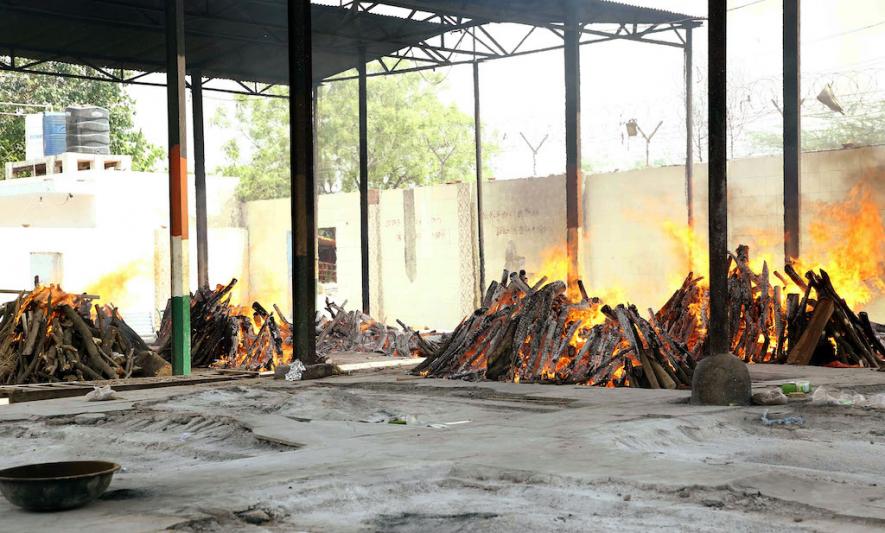WHO Report on COVID-19 Excess Deaths: Modi Government’s Attempt to Shoot the Messenger

Last rites of people who died due to Covid-19 are being performed
The Indian government's refusal to consider the World Health Organisation (WHO) estimates of excess deaths during the COVID-19 pandemic years and insisting that only India's Civil Registration System should be used for COVID-19 deaths makes strange reading. WHO has estimated excess deaths for all countries, countries with stronger birth and death registration systems than India. Even for such countries, e.g., the UK, the US, Germany, and France, WHO's report shows that excess deaths have been much larger than the registered COVID-19 deaths. India has not been singled out for this exercise. But it is the only country arguing against any modelling of excess COVID-19 deaths!
Is this, therefore, another example of "narrative management", something that the Modi government has specialised in? The Indian Express had reported that the Principal Economic Advisor in the Ministry of Finance, Sanjeev Sanyal in 2020 had prepared a 36-slide presentation on the danger of India's ratings dropping sharply to junk status: "Subjective Factors that impact India's Sovereign Ratings: What can we do about it?" Shorn of all the management jargon, it argues for "massaging the message" to improve ratings, even if the underlying data is bad.
Though the WHO excess death exercise has been widely reported, let us look at its broad conclusions. First, the key global conclusions:
- The WHO calculated every country's excess death for 2020 and 2021.
- India, Russia, Indonesia, the US, and Brazil have the highest number of excess deaths.
- In death/100,000, India does not rank very high; it is roughly in the same range as Russia, South Africa, Brazil, the US, Turkey, etc.
If we summarise the conclusions, the reading of WHO's exercise will lead us to conclude that India's overall performance in the handling of the epidemic was not particularly bad. If we leave out China, which is following a no-COVID-19 policy, India has a population four times that of the US, the next biggest one. By India's population size alone, we would expect it to have the largest number of COVID-19 deaths, which is what the WHO exercise also shows. If we compare deaths/100,000, a better performance measure between countries, India is not so bad. It is in the company of larger middle-income countries, e.g., Brazil, South Africa, Indonesia, and even some rich countries like the US. India differs from others in the ratio of excess COVID-19 deaths to the declared COVID-19 deaths. This means that the government has done a significant undercounting of India's COVID-19 deaths.
The GoI's response to WHO's exercise has been that it should not have used any modelling for excess deaths but relied only on Civil Registration Systems (CRS) data as the authentic estimate of COVID-19 deaths. As many experts have pointed out, this makes very little sense. The CRS data on 2020 came out only two days before the WHO's results were presented, and its 2021 figures are yet to come out. If we take the GoI's response seriously, no excess death studies should be done!
This is also strange as the Modi government has been quite fond of using epidemic modelling to tell us how wonderfully the government managed the COVID-19 pandemic and how the Indian "supermodel" showed that India would shortly be COVID-19 free. This was just before India got hit by the delta wave in 2021, causing virtually the collapse of the hospitals and the supply of oxygen. Is the government arguing only models that show everything is hunky-dory should be used and not anything that shows us in an unfavourable light?
Before we look at WHO's conclusions, let us understand what is "excess death" and why is it important to estimate this figure?
Excess deaths during an epidemic are the additional deaths that are not counted by government agencies as deaths due to the epidemic but are due to the direct or indirect effects of the epidemic. In the case of COVID-19, additional deaths could be due to simply not registering deaths or not registering them as COVID-19 death, particularly during a wave. Or people postponing routine care and other programs like routine vaccination, TB care, etc., suffering as health agencies focus more on COVID-19. The computation of excess deaths compares the likely deaths based on past data with no epidemic to the estimated deaths during the epidemic period.
Prof. Gautam Menon, an expert on modelling and biostatistics, also tells us that any such exercise has to compensate for indirect factors such as deaths due to traffic accidents, accessing medical treatment during the pandemic, etc. Only then we can arrive at the final estimate of excess deaths due to the pandemic alone.
Why do we estimate excess deaths, even in countries where the death registration system is quite strong? And why do even these countries also show fairly high excess death figures? India is not alone in undercounting deaths due to the COVID-19 epidemic. Even in the US, which boasts of a superior death and birth registry system, the excess death figures in WHO's Report are three times its official figures making it the country with the fourth-highest COVID-19 deaths globally.
What are WHO's estimates for excess deaths for the world and India?
WHO Report estimates that the total deaths from COVID-19 for the two years 2020 and 2021 are about 14.9 million deaths globally and about 4.7 million deaths in India. However, the official Indian COVID-19 toll for the same period is 0.48 million, or WHO's estimates of COVID-19 deaths are about ten times higher than India's official figures.
Are the WHO's estimates for India much higher than other estimates carried out by different groups? According to Menon, the WHO's figures are within the same ballpark as other estimates carried, which vary from two million to six million, or four to 12 times the official figures.
Why then is India the only country disputing the WHO's figures? Instead of arguing why WHO's approach to excess mortality is faulty, it has launched a broadside against the use of modelling to estimate COVID-19 deaths. The reason for this seems to be the inability to advance any compelling arguments rejecting such an exercise and perhaps the knowledge that any independent approach would expose the serious undercounting in the official figures of COVID-19 deaths. The WHO's and the other exercises in modelling excess deaths have shown that the highest number of excess deaths occurred during the two earlier waves, particularly during the delta variant wave in 2021. This matches with what we know empirically.
The newspaper reports during that period detailed major differences in figures in major cities for cremations and burials done under the COVID-19 protocol and the COVID-19 deaths as declared by the government. This mismatch would have been worse in the rural areas, with bodies floating down the Ganga, as people did not even have the money for proper cremation or burial. To claim or expect adequate recording for deaths in this period as the government claims is the height of folly.
If the government claims that the WHO's approach is faulty, setting up an independent committee with appropriate credentials and even international participation would be the proper course. Make data available to them, devise methods to estimate excess deaths due to COVID-19 and let such a committee function independently of the government. A transparent procedure, making all data available, and a public discussion of the methods could produce a credible report; instead of an ad hominem attack on the WHO Report. Unfortunately for India's credibility, it is the only country among the 194 member countries of the WHO to reject the report.
The Modi government's approach is first to try and manage the narrative. Then, if that does not work, shoot the messenger. The problem is that if both fail, then what? That is the credibility crisis this government faces, ranging from inflation to COVID-19 deaths.
Get the latest reports & analysis with people's perspective on Protests, movements & deep analytical videos, discussions of the current affairs in your Telegram app. Subscribe to NewsClick's Telegram channel & get Real-Time updates on stories, as they get published on our website.























